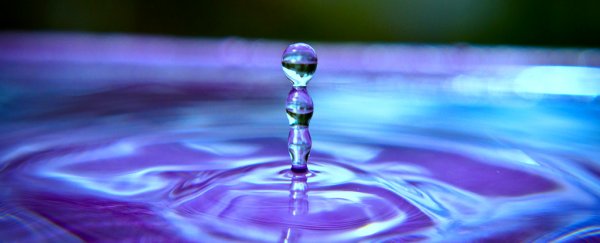It's easy to feel like the quantum world is incredibly distant from your everyday experience, so here's something you can do to bring it closer to home. Go grab a coin and put it under slowly dripping water. If you have a pipette, that's the way to go. Otherwise, a dripping faucet will work.
Try enough times, and eventually you'll be able to get the water to pile up on your coin in a big, bulbous blob. According to a new study, part of the reason the drop holds together like this is because water molecules act like little, quantum-tunnelling gears. Okay great, you can sit down now.
Water molecules are made of a big oxygen atom and two smaller hydrogen atoms, with electrons buzzing around the whole group. On average, the electrons spend more time buzzing around the oxygen and less time buzzing around the hydrogen, so the oxygen tends to be negatively charged, while the hydrogens tend to be positively charged.
If you put two water molecules next to each other, the oxygen of molecule 1 tends to attract the hydrogens in molecule 2, and the molecules will end up with the oxygen and one hydrogen really close together. If you put a whole bunch of water molecules together, they'll arrange themselves so one molecule's oxygen is always next to another's hydrogen.
And then, because molecules are always jiggling around, they'll occasionally switch from lining up with one set of neighbours to lining up with another set - the common metaphor being that water molecules are dancers who like to switch partners. The whole process of attraction and partner-switching is known as hydrogen bonding, and it's the underlying reason for surface tension - the tendency of water molecules to clump together instead of spread apart. That's why water drops can get so big.
But there are a couple of holes in this explanation. If all of the water molecules are in groups, how does one find another partner without disrupting the whole dance? And what happens if they're not jiggling enough to keep switching? Does the drop just collapse?
These were the questions asked and answered by physicists at the University of Cambridge in the UK, by looking at supercooled arrangements of just six molecules.
First, they checked what happens when one of the molecules switches partners, and found that you don't just get one molecule at a time doing the switch. The molecules always work in pairs, like interlocking gears. When one turns, it frees up a hydrogen bond that can be taken by the other and there's never an awkward partnerless period.
But that's not all. The molecules in these experiments weren't jiggling enough to do the switching on their own, so the team turned to simulations to see how the gears were working.
Quantum particles (okay, all things in the Universe, but let's not go there) don't have a well-defined position. Instead, their positions are kind of spread out across space: it's most likely that they'll be where you expect them to be, but they could also end up somewhere else, even if they don't have enough energy to get over there. It's like if you threw a ball at a wall and the ball, instead of hitting it and bouncing back at you, just went through without breaking the wall. Your ball would seem to have accessed some sort of tunnel between your and the other side of the wall when no such tunnel exists.
This is how water is able to switch partners, according to the new simulations, published in Science this week. The molecules aren't jiggling enough to do it on their own, so they have to rely on quantum tunneling in order to set this molecular clockwork in motion. Instead of actually searching for a new partner, they just appear next to the new partner and switch immediately. The two molecules that work together in the gears coordinate their tunneling so that none is ever without a partner.
Not bad for a little bulb of water.

